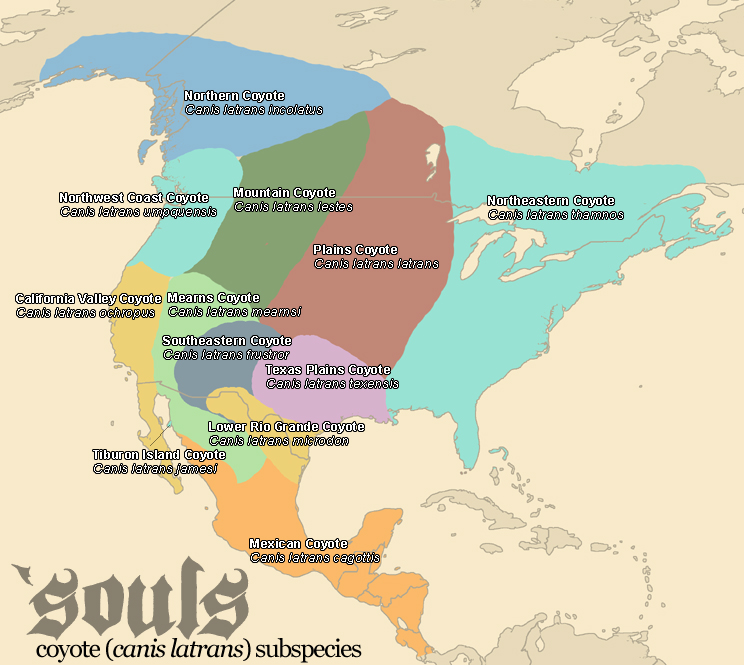Table of Contents
Coyotes
If you've never roleplayed a coyote before, never fear! It's not so different from playing a wolf! Here's some basic information to help you get started roleplaying a coyote within Inferni.
Coyote Percentage Guidelines
It's easy to calculate percentages where canines have direct coyote ancestors:
- Coyote's parents are two coyotes: 100% coyote
- Coyote's parents are a coyote and a half coyote: 75% coyote, 25% other
- Coyote's parents are a wolf and a coyote: 50% coyote, 50% other
- Coyote's parents are half coyotes: 50% coyote, 50% other
It gets progressively harder to calculate percentages where canines have distant coyote ancestors or where canines have a lot of mixed heritages:
- Coyote's mother is 75% coyote and 25% wolf, father is a wolf: 37.5% coyote, 62.5% wolf
- Coyote's mother is 75% coyote and 25% wolf, father is half (50%) wolf, a quarter (25%) coyote, an eighth (12.5%) jackal and an eighth dog: 50% coyote, 37.5% wolf, 6.25% jackal, 6.25% wolf.
- Coyotes mother is 62.5% coyote, 25% jackal, 12.5% wolf, and 12.5% dog; father is 50% wolf, 25% coyote, 12.5% jackal and an 12.5% dog: (approximate) 43.5% coyote, 25% wolf, 18.75% jackal, and 12.5% dog.
Appearance
Coyote Links
Coyote sizes vary; the largest run to 70 pounds, while the smallest may weigh as little as 25 pounds, with an average of 50 pounds. Coyote colors are generally more vivid and brighter than wolf pelts, possessing more browns, yellows, and reds. Coyotes are rarely melanistic and cannot have pure white coats without albinism or hybridization present.
Behavior
Coyotes are intelligent and extremely versatile, able to adapt to a variety of different living conditions. Coyotes are excellent runners and jumpers. Their voices tend to be of higher pitch than wolves, and their howls are distinctively different.
Listen to coyotes howl! Watch a coyote video*!* Be aware, there is some foul language in this video!
Social Life
Coyotes are often characterized as loners, but they frequently live in smaller groups and mated pairs. Their hierarchy tends to be more fluid and less cohesive than wolf packs. Inferni adheres to this: dominance and submission aren't a big part of Inferni's hierarchy, and coyotes do frequently come and go from the clan.
Diet
Coyotes tend toward smaller food than wolves; small mammals are commonplace. Coyotes have a varied diet, however, and will eat many different things.
Hybridization
Hybridization @ RP Guide"'Coydogs,' hybrids of Coyote and domestic dog, especially shepherd mixtures, are larger, usually lack [the] dark vertical line on lower foreleg, and have relatively shorter and thicker snouts." Experimentation with coyote-dog hybrids found that after a few generations, there were higher incidences of genetic problems in coydogs bred back with dogs, although this is generally unverified outside of one study. A coydog cross depends on the breed(s) of dogs introduced to the coyote blood, naturally—resulting hybrids typically have a rather feral appearance with clear canis familiaris traits present.
Coywolves are generally much larger than coyotes, with much wider snouts and larger skulls than a purebred coyote. Hybridization with wolves has happened historically, and as coyotes' ranges expanded and wolves' ranges diminished, some hybridization occurred "and helped turn coyotes from mousers of western grasslands to deer hunters of eastern forests." The so-called "eastern coyote" is considered to be a distinct hybrid subspecies of wolf and coyote—individuals with as much as 89% wolf heritage have been identified in Pennsylvania.
Range
Coyotes are found only in North America. If your coyote comes from overseas, remember -- you must have a plausible backstory as to how a North American species is in, for example, Russia. o: Here are some ideas, but you might have some of your own:
- One acceptable option for an overseas coyote is playing a character descended from zoo populations (though this is likely to result in coyote-wolf or coyote-jackal hybrids -- a pure coyote descended from a small zoo population 20 years ago is highly unlikely without a very large zoo population or severe inbreeding).
- A second option is a parent or grandparent crossing the ocean to go live overseas, though this would be a more recent development (~2005 and earlier -- Luperci probably weren't sailing the oceans in 1989, after all). Your character could then be motivated (or forced) to return to their "ancestral coyote homelands" or something to that effect.
More Information
The 'Souls RP Guide has a ton of information about coyotes, ranging from coyote subspecies to some essential information on the nominative species page (Canis latrans latrans). We encourage you to check it out!
Coyotes @ 'Souls RP GuideQuestions?
If you're not sure about how to play a coyote, feel free to contact the leaders with your questions.


